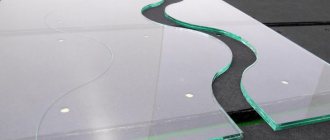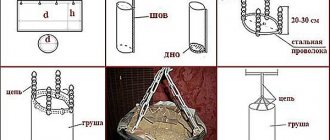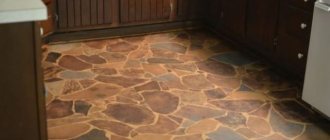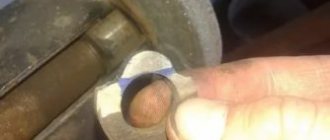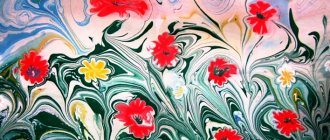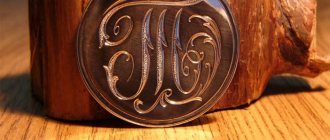Stone is a popular material for finishing building structures of a private house. Such natural decor is difficult to work with, and it is not cheap. Therefore, let's look at how to make artificial stone with your own hands at home to facilitate the process and save on finishing. Read to the end and find out what kind of material this is, its disadvantages and advantages, varieties. We will tell you about the technology of making stone using and without matrices, what it is used for, what types of forms exist for it.
Artificial stone in the interior Source sad-dom.com
Main features of artificial stone
Various materials are used to make stone decor. Their choice depends on the place where the artificial stone will be used. Thus, indoor building structures are often finished with gypsum stone. Facades are usually faced with a material made from a cement mixture and various components.
Additives include materials that make it possible to obtain a relief pattern on the finished decor. For these purposes, stone chips, sand, fine gravel, and so on are used. In production, coloring pigments in dry and liquid states are also used. With their help, stone facing material of artificial origin is given the required shades.
Artificially formed stone decor is cast in special molds or made even without their use. This distinguishes it favorably from materials of natural origin. Professionals, strictly following production technology, create artificial stone with lumpy, smooth, layered, fine-grained and other textures.
Layered texture of artificially formed stone decor Source gesso3d.ru
Advantages and disadvantages of artificially formed stone
Making decorative stone material is a creative work. For professionals with relevant experience, this is an easy process. At the same time, artificial stone has a number of other advantages:
- light weight, which is significantly less than that of a similar natural material, which allows for simpler transportation, processing, and installation;
- the ability to always produce additional volumes of products if there is a shortage of finished material for cladding specific structures;
- real quality control at every stage of production;
- possibility of casting directly at the site where installation is carried out;
- the presence of a smooth back surface, which makes decor installation easier;
- high fire resistance, allowing cladding of fireplaces, stoves and other similar devices;
- availability of components at low prices;
- variety of shapes, colors, sizes, textures.
Different colors and textures of artificial decorative stone Source vitrum-novo.ru
Before you make an artificial stone with your own hands, you definitely need to get acquainted with its disadvantages. Thus, some varieties of this material are manufactured exclusively using complex technologies. Organizing such production requires large financial costs.
Another disadvantage of artificially formed stone decor is that it is less durable than natural material. Although the service life can be 40 years if all rules for the care and maintenance of the lined surface are followed.
Preparatory stage
- remove old finishing material;
- carefully scrape off all the scraps that, one way or another, may interfere with you in the future;
- inspect the wall for cracks and irregularities;
- if you notice cracks, then use a hammer and chisel to make them a little wider and fill the holes with a deep penetration primer - this will help prevent the appearance of always unwanted mold;
- carry out the initial treatment of the wall surface with a primer - it is not necessary to achieve a perfectly smooth surface, since after puttying the priming procedure will have to be repeated;
- if the surface is very uneven and there are noticeable defects, then go over the wall with plaster, and also cover the cracks previously treated with primer;
- to achieve a perfectly smooth wall after plastering, it makes sense to use gypsum-based putty - it is not so rough in consistency and will help make the wall flawless, eliminating those irregularities that plaster, for objective reasons, cannot cope with;
- the final touch is re-priming the surface, this time we are pursuing the goal of achieving excellent adhesion to the decorative material that will be used to imitate brick, the treatment must be carried out carefully, generously lubricating those areas that very quickly absorb the solution.
Popular articles Picture-amulet “Horseshoe”
How to check if your wall is ready for the next stage? Everything is very simple: run your hand over it - if you don’t feel any obstacles or unpleasant roughness, it means you have successfully completed such a tedious, but still necessary preparatory stage.
Types of artificial stone
Only in accordance with the technology and with strict adherence to the recipe is it possible to obtain high-quality decorative building materials. Today, artificial stone is made using different methods. This allows you to obtain a material that differs in name and properties:
- Reinforced monumental stone made from concrete mortar.
It is produced individually by hand using free forming. Its production is carried out directly at the installation site. This technology allows you to create artificial boulders, granite slabs, and cobblestones.
Artificial boulder made of reinforced monumental stone Source baltiya-garden.ru
The mixture for materials is prepared on the basis of dry sand and cement. During its preparation, the components are mixed 1:3. At the same time, from 2% to 6% of pigment is also added. Its amount is calculated depending on the mass of the mixture. When preparing the solution, polymer-based additives are also used.
- Cement-sand molding stone material used during finishing and construction work.
Before you make a decorative stone with your own hands, you need to get acquainted with its properties. The material has increased resistance to low temperatures and excellent strength. The production of this type of stone can be carried out during the cold season. Typically, the manufacturing process is organized in workshops, garages and hangars.
- Artificial stone material based on gypsum.
Its casting is a simple technology that requires a minimum amount of equipment. Stone production is carried out in the warm season or in heated rooms. In this case, the material is used exclusively for internal cladding, as it is not resistant to temperature changes.
Artificial stone material made from gypsum Source prom.st
See also: Catalog of companies that specialize in finishing materials and related work
The mixture used is characterized by rapid hardening. Therefore, it is prepared in small portions, which are immediately poured into special matrices. Typically, no more than 4 minutes are spent on kneading and filling molds. In the production of such decorative stone, water is used, as well as citric acid to slow down the hardening process. Its amount is calculated depending on the weight of dry gypsum and is 1.3%.
Pigments are also used. Their amount is also calculated by the mass of gypsum and usually ranges from 2 to 6%. When selecting the optimal color option for the finished product, several samples are made, during the production of which different percentages of pigment are added to the mixture.
- Ceramic artificial stone is one of the most expensive facing stone materials.
Its production is carried out under exposure to high temperatures by firing or using the hardening method. The manufacturing process is always carried out in a heated room.
Ceramic stone in the bathroom Source pinimg.com
- Polyester decorative stone material obtained using synthetic substances.
Its production is carried out using hot hardening. Mineral fillers are used to make stone. During its production, a vacuum environment is created, which is required for curing the material. Therefore, production is carried out only in specially equipped workshops.
- Cast decorative stone made of acrylic, the production of which is characterized by cold hardening.
The material is produced using a vibration stand and strictly according to the instructions. Many of its properties are superior to those of other similar stones. In this case, it is possible to change the shape of the acrylic material when exposed to high temperatures and without loss of quality. Its maximum value is 210°C.
On a note! Decorative stone made of acrylic is characterized by the absence of pores and resistance to chemical reactions. It is able to provide a high level of hygiene. Therefore, it is often used in bathrooms, swimming pools, corridors, kitchen areas, terraces and verandas.
Decorative acrylic stone Source sense-life.com
- Liquid decorative stone material on gelcoat.
Its hardness is lower than that of cast stone. The reason for this is the smaller amount of mineral fillers used. Products of complex shapes are made from the mixture. In production, 2 types of composition are used. They differ in components and percentage of filler.
So, the primer composition of the gelcoat is 20%, and the front composition is 40%. The back compound is also used. It consists of a filler to which pigment is added in an amount of maximum 6%. The applied compounds set within 30 minutes, but decorative stones on the gelcoat are laid only after 24 hours.
Liquid stone product Source filigrano.by
How to achieve the desired color
Pigments for artificial stone
To give artificial stone a beautiful look, you can first paint it. How to do it? Special pigments are used for coloring. For example, they can be applied to the mold immediately before pouring the solution into them. In this case, the form must be partially painted over, which allows you to create an imitation of natural stone.
Note!
It is extremely important to use not just a color for paints, but a high-quality pigment. They are iron oxide inorganic dyes.
To prevent the paint from cracking or washing off, it is mixed with a fresh solution and first applied to the mold. Subsequently, it will penetrate approximately 3 mm deep into the stone. And this is enough so that the paint does not wash off. As for the volume and quantity of pigment, its specific proportion is determined by the sampling method. To do this, you can make several experimental tiles and, after drying them completely, see what color you get. This is the only way to achieve exactly the color you need.
Let's consider three methods of making stone: from gypsum, acrylic and cement.
Matrices for decorative stone material
There are different options for how to make a stone with your own hands. However, most of them are based on the use of special forms. Such matrices are available in different designs. There are more than a dozen varieties of them.
Different options for matrices for decorative stone Source twimg.com
Despite the large number of types of matrices, the following types of forms are most often used:
- Polyurethane matrices in finished form, used for the manufacture of small quantities of stones. They are durable and expensive
- Lost wax molds made of clay. They are used when applying wax. With their help, artistic casting and modeling are performed.
- Silicone matrices, which are used in small industries. Such forms allow the stone to be produced individually. Silicone matrices become deformed during operation. This allows you to make only about 10 castings.
Advice! Silicone matrices should be used on a sand bed. The reason for this is their change in shape when exposed to vibration and heat. Before casting begins, sand is poured into the pan, and then the matrix is deepened into it by a third of its height. In this case, be sure to check the horizontal position of the form using a level.
Surface preparation
Before applying decorative plaster, the wall needs to be prepared. The surface must be completely cleaned of various coatings and made smooth. Although, no one demands perfect smoothness from you. Be sure to remove all salt bulges and grease stains. Only after this can the wall be primed. This is necessary to improve the contact of decorative plaster with the wall. By skipping this step, you risk getting an unreliable final coating.
In nature, masonry is made up of different sized stones. We will consider the option of laying on a flat surface, without bulges. Stones, just like in natural masonry, will have a variety of sizes. For this we only need imagination, a wallpaper knife and masking tape.
The primed wall must be covered with strips of masking tape. Thereby defining the seams between the stones. Cover the entire wall at once, even if the area of the room is very large and the decorative plaster is planned to be applied in certain portions.
Using this method you can create an imitation of brickwork. Simply tape the wall parallel to the floor with strips of tape to create straight horizontal lines. And then, using masking tape, make future vertical seams. This way you get a lot of small bricks, as if it were real brickwork.
A simple way to make decorative stone
This option involves the production of artificial stone material by pouring 2 layers of the mixture into a mold. First, 3 parts of sand and 1 portion of cement are combined. Then the liquid dye is diluted with water. Its amount is usually approximately 2-3% by weight of cement. Then water with pigment is added to the cement-sand mixture until a homogeneous mass is formed, similar to thick sour cream.
The prepared solution is poured into the artificial stone matrix. It is only half full. Then the mixture is compacted and evenly distributed by shaking the mold and tapping, for example, on a table or other base on which the matrix is located.
A metal reinforcing mesh is laid on the first layer and the second part of the solution is poured, which must first be prepared without pigment. Then two lines are drawn crosswise on the surface of the mixture. They will improve the adhesion of the material during installation.
After about 12 hours, the hardened stone is removed from the matrix and dried. Then the mold is cleaned, washed and poured again.
Making gypsum stone
In the production of decorative stone materials, building gypsum is often used. A mixture is prepared from it, the consistency of which should be similar to thick sour cream. When mixing, a pigment of the required color is also used.
The prepared mixture is poured into a silicone mold only up to half its height. The matrix is pre-lubricated with grease. Then a fine metal mesh is laid to enhance the strength of the stone. The mold is then filled to the brim with a mixture that lacks pigment.
The filled matrix is shaken several times so that the gypsum mixture is evenly distributed in the mold. If the curing process occurs quickly, then milk is used during mixing. It reduces the speed of setting of the mixture.
Making decorative stone without using a mold
The production of artificial stone material is carried out not only using special matrices. It is also possible to make such decor without the help of molds. This option is very simple. Despite this, it allows you to produce original stones for cladding building structures in a private house.
Before you make an artificial stone without a shape with your own hands, you need to prepare a stencil. It is performed on ordinary oilcloth. Instead, a cardboard sheet of suitable size is often used. The dimensions of future stones are drawn on the selected material.
Although the entire process of making artificial stone decor is simple, it requires time and minimal experience in working with building materials. Therefore, it will be easier for many to purchase ready-made products and hire specialists to install them.
Decorative stone created without using a mold Source samsmogy-remont.ru
The process of manufacturing artificial stone decor is performed as follows:
- Construction plaster is mixed with water in a silicone container. Instead, you can use any container, inside of which a garbage bag is previously placed. Moreover, you can always throw it away after use.
- The stencil is protected with transparent oilcloth.
- The prepared mixture is distributed over the surface of the oilcloth within the boundaries indicated on the stencil.
- The drying gypsum mixture is given the required relief. To do this, use spatulas of different sizes.
- The drying gypsum mixture is divided into separate fragments in accordance with the markings on the stencil.
- The finished hardened tiles are removed from the oilcloth after about 15-20 minutes.
- Tiled decorative material is dried for 1 day.
Preparing the mixture
Usually, when working on wall finishing, ready-made solutions are purchased for application. In this case, to prepare the mixture, you will need to pour the composition into a large container, fill it with water in the ratio indicated on the package, and then stir using a special mixer. It is necessary to stir until the mixture acquires a homogeneous consistency.
It is recommended to use stirring in two stages, this will create a homogeneous mixture without lumps.
A mixer attachment is used for mixing.
Area of use of decorative stone
Thanks to its significant advantages, artificial stone is an ideal finishing material. It is used indoors and on facades, depending on the manufacturing method. In addition, certain types of material are used to manufacture specific products. Let's take a closer look at what can be made from artificial stone:
- countertops for kitchen furniture, which are highly resistant to damage;
- bar counters that are durable;
- sinks and sinks that have an attractive appearance and original design;
- window sills of various sizes and shapes;
- coffee and dining tables;
- stylish and custom mirror frames;
- shelves in a variety of colors.
Stone shelves in the interior Source design-homes.ru
Decorative stone material is used to create wall panels, when cladding steps, railings, and arched structures. The use of artificial stone in the interior and when arranging a garden plot is an indicator of respectability and excellent taste.
Briefly about the main thing
Artificial stone is a material made from cement and sand. Gypsum is also used. The composition also includes water, dyes, and plasticizers. Ceramic, polyester, acrylic, reinforced and liquid stone on gelcoat are also produced. They are used to create shelves, sinks, furniture items, and boulders.
The material is lightweight, fireproof and affordable. It is made in different colors, shapes and textures. Its durability is less than that of natural stone.
During production, molds are used in which the mixture hardens. Coloring is done during the mixing process or after the tiles have dried. There is a manufacturing option using a lined stencil and without a mold.
Stone boulder for the garden from polyurethane foam at home
You can use cement to create large stones, or you can use foam. Such a cobblestone will weigh less and you won’t have to wait long for the cement to harden.
To work you need:
- 3 cans of frost-resistant foam,
- Large basin or other frame,
- Paint, brushes.
If you have an old basin (plastic or iron), then it will do just fine. Instead of a basin, you can crumple newspaper into balls and fasten them together.


